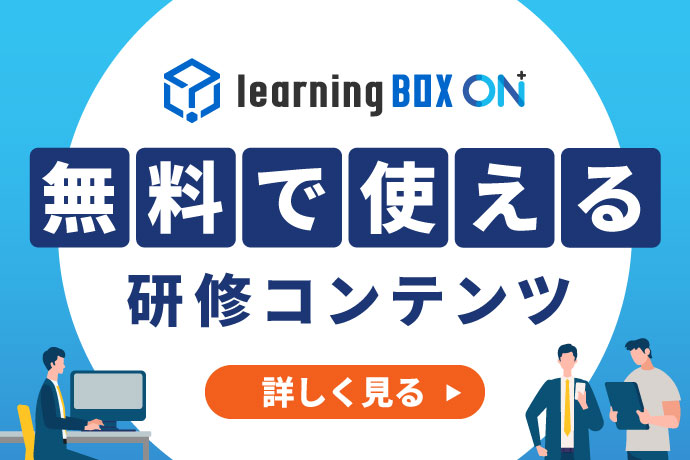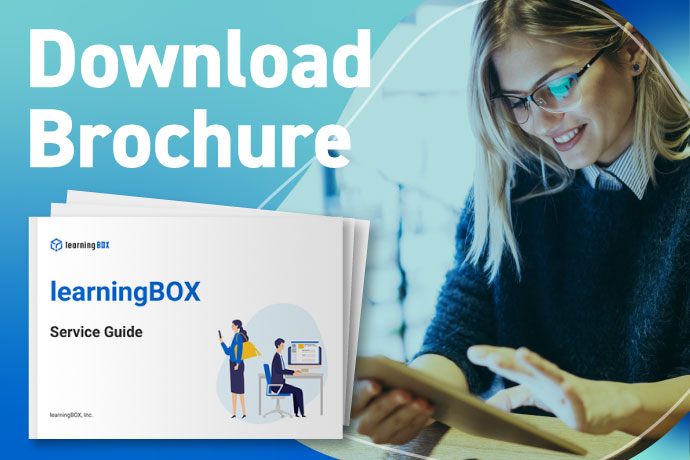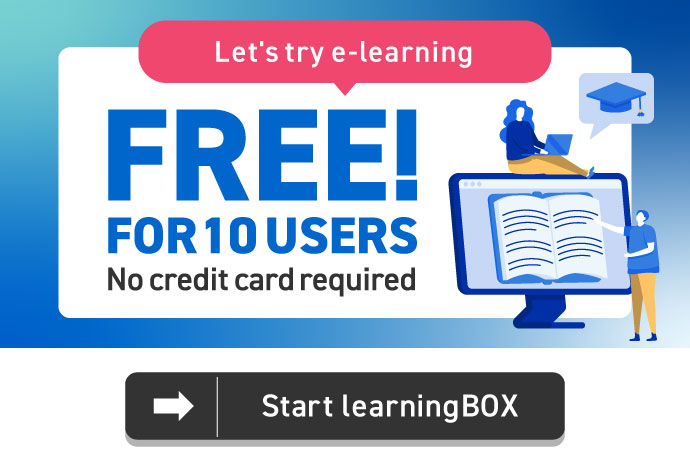What's the purpose of training?
examples and the keys to a successful in-house training program

Training is provided at various times, such as when a new employee joins the company or is promoted.
For developing efficient human resources, training plays important roles. But what is the purpose of them? Focus on the environment at your organization and select the proper one to overcome the challenges you are facing.
This guide explains the types of employee training programs, the pros and cons of each, and points to note.
Three categories of in-house training

In-house training falls into three main categories depending on their purpose. Before conducting one, you need to grasp which training you are working on.
Below are the types of training and specific examples of each.
(1) Training by level
Hierarchical training is what is conducted for each level of employees. The purpose is to develop the skills and attitudes essential in their position.
e.g.) new employee training, management training, etc.
②Occupational training
Occupational training is training in specialized knowledge tailored to the needs of each job category, and is generally conducted by department. Through the training, each employee can improve their practical skills such as sales skills for salespeople, correspondence skills for those who are at a call center, computer and bookkeeping skills for general affairs and accounting.
e.g.) sales training, human resources training, marketing training
③ Thematic training
Thematic training is one of the training methods that picks out the ideas and skills that you want them to acquire and focus on. Training themes are selected based on the company's business development and the challenges it faces. The purpose is to have trainees learn what meets your wants, regardless of their job level or position.
e.g.) communication training, risk management training, business manner training
Back to ContentsOJT and Off-JT

There are two major methods of training. It is essential for effective in-house training to understand the difference between them and utilize them according to each purpose.
Below are the pros and cons, and the differences between each training method.
OJT (On the Job Training)
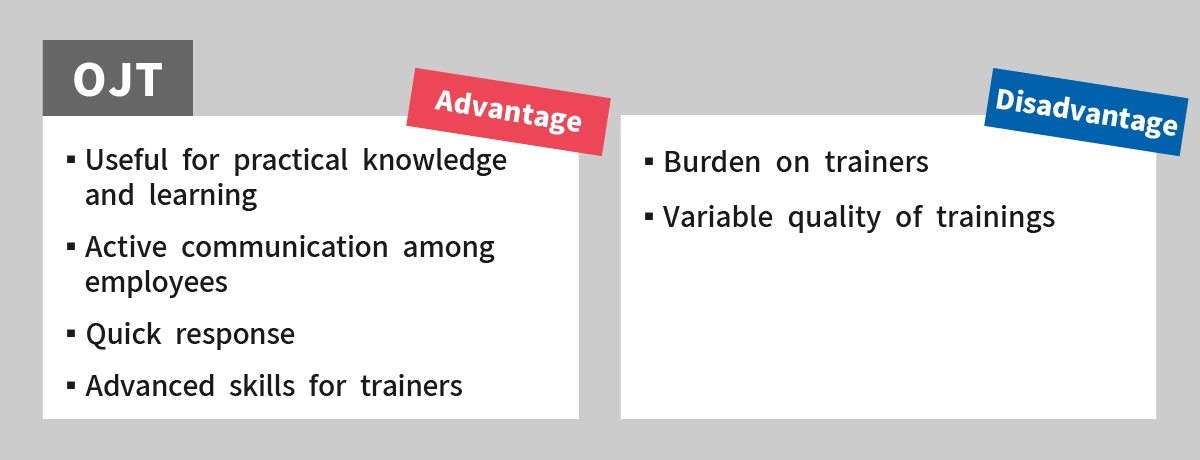
OJT (On-the-job training) is a method of training in which trainees acquire a variety of business knowledge through practical experience in the actual workplace under the supervision of an educator. It is conducted in the course of regular work duties, with experienced supervisors and senior employees in the department serving as instructors. Through the training, trainees can have an opportunity to acquire practical knowledge and skills that are not found in manuals.
The purpose of this training method is to have the trainees output the knowledge they have actually learned through their work, and to expect to start them off on their right foot.
Another feature of OJT is closer relationships between trainers and trainees. It allows the trainees to ask questions directly and to have opportunities to communicate with each other within the department.
However, if trainers are teaching while performing their regular duties, they may not have enough time to do like above. In order to provide solid indication, avoid assigning a trainer from the division which has a shortage of staff or a busy season.
Off-JT (Off the Job Training)
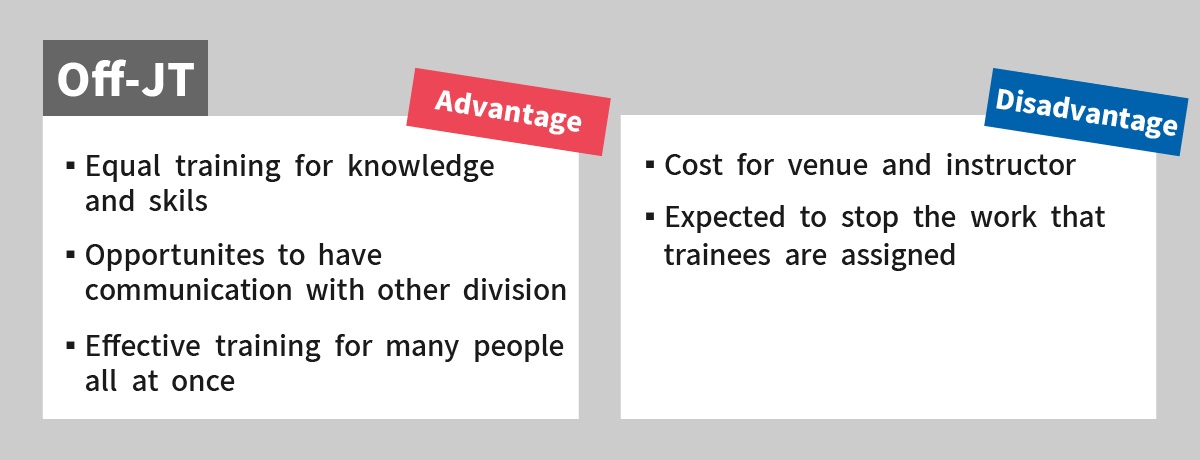
Off-JT is another method of training which is conducted by the in-house trainers or outsourced instructors. Through the training, it is expected for trainees to enhance the business skills and understand the organization's ethics required for implementing the job.
One of the efficient elements for this method is giving equal training to employees in the same place. Compared to OJT which tends to be focused on teaching knowledge about the job at hand, Off-JT allows trainees to learn broad knowledge through lectures.
Although there are advantages as above, you should take into consideration that the cost of outsourcing to instructors or renting a venue can be disadvantages when conducting this training.
Back to ContentsE-learning training is on the rise
Both OJT and Off-JT have advantages and disadvantages, and it cannot be said which is more effective. The important thing is to compare each feature and optimize the advantages for training which meet your needs.
As one of the Off-JT, e-learning has been put a spotlight on. Since the COVID-19 disaster, the method of employee training has shifted the same as the work style.
An increasing number of companies are now adopting it for its various advantages.
For example, trainees are able to utilize their spare time. E-learning does not require a specific place or time to work on; they can learn whenever or wherever they are. Also, interactive learning will result in deeper knowledge since they can take courses again and again. Another reason that e-learning is chosen as an effective training method is reducing the burden on companies in many ways such as cost of venue, instructors, printing handouts, and more. As written above, e-learning or LMS (Learning Management System) has great effects on training both in trainees and companies. Of course, some companies put more emphasis on face-to-face training than on-line learning. Therefore, combine the methods depending on the purpose and future vision of the company.
Three successful keys

We suggest three keys for successful training below.
(1) Clarify the purpose
The most important thing to provide training is to clarify the purpose. Without it, the content will be away from the goals and you cannot expect to improve employee engagement.
The objectives should be specific rather than abstract, which will enhance their knowledge and skills. Moreover, a high level of engagement plays a role to motivate them in their workplace.
As an example of specific goal setting, “acquire communication skills for sales performance” will be preferable compared to “brush up on their skills”. The more specific it is, the better result it is expected to lead to.
(2) Tailored to the level of the target audience
Depending on the abilities and skills of employees, strategies will vary. For new hires, there will be differences between new graduates and mid-careers.
What element is needed for trainees? How do you compensate for the skills they lack? Is there any appropriate trainer for new hires in your organization? Including the possibility of offering outsourced instructors, look over the situation of your organization.
(iii) Follow-up after training is also important.
The training is not the end of the process. To make training more effective, follow-up after taking the program is necessary.
Some trainees may be concerned about their skills and knowledge, and some may be nervous even after the training. Ask them how they feel to make their concerns clear and encourage them to maximize their abilities in their workplace.
Summary
There are some kinds of methods to provide training programs. In order to develop human resources, it is the most important thing to clarify the purpose of them. What is the goal? What skills does your company want employees to acquire?
If you are interested in e-learning as a training method, learningBOX is recommended. It is an intuitive LMS (Learning Management System) and allows you to create your own materials without specialized IT knowledge.
Many companies have already implemented our system for employee training. Try our Free Plan. It is free for up to 10 accounts without a trial period.
▼You may also like:
Back to Contents

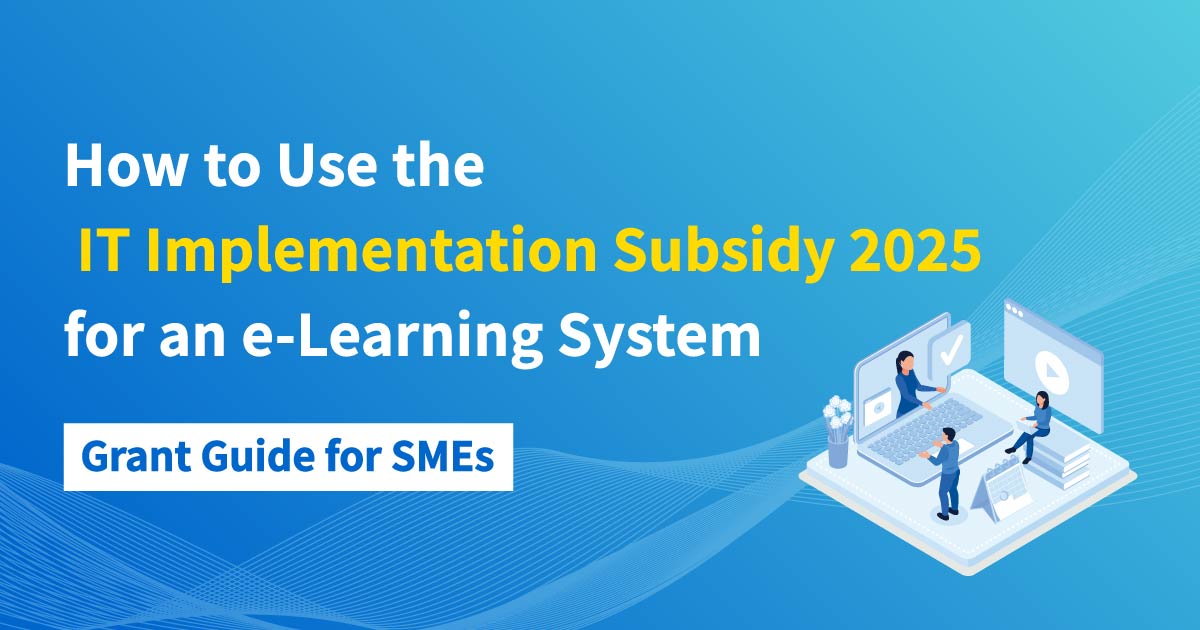
-
Discover rich featuresService Guide
-
Feel free to contact usGet in Touch
-
Try our Free PlanTry Free Plan




